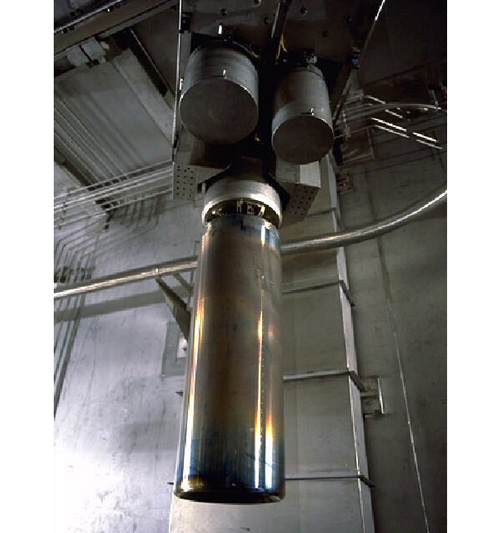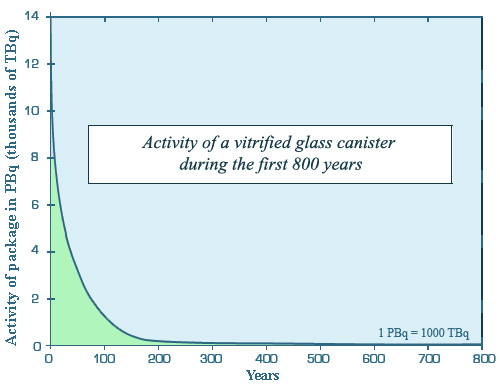Spent nuclear fuels and vitrified waste
High-level waste is waste for which management is a priority. Its very high levels of radioactivity are due to the presence of highly radioactive atoms in the spent fuel unloaded from reactors.
The radioactivity level of a fuel assembly weighing nearly 500 kg, when it comes out of a reactor, is around 46,000 TBq (terabecquerels), or 92.5 TBq per kilogram. This 92.5 TBq/kg will have dropped to 14.8 TBq/kg after 10 years and to 1.85 TBq/kg after 100 years. To give an idea of the scale of these radioactivity levels, remember that 1 terabecquerel alone is equal to 26.95 Curies or grams of radium, the Curie being the radioactivity of the historical gram of radium isolated by Marie Curie.

Vitrified waste packages
This container has been filled with vitrified high-level waste in the vitrification facility at the La Hague reprocessing plant. The glass incorporating the fission products and actinides releases heat, which means that cooling is required inside the ventilated shafts where the packages are stored awaiting future disposal.
© AREVA /Sydney Jezequel.
Even after 100 years the activity level of spent fuel assemblies is still high. Countries like the US have chosen to treat them as waste. Pending a decision about a final geological disposal or a reprocessing, they are initially stored in pools. They are then placed in large containers of several tonnes, known as ‘casks’, which have thick walls and cladding that surround the irradiated fuel rods to provide protection from radiological risks.
France has chosen to reprocess the irradiated fuel from reactors. During reprocessing, the fission products and the minor actinides, responsible for more than 98% of the radioactivity, are separated out for conditioning in blocks of glass. This vitrified waste is what constitutes France’s high-level waste. It is placed in steel containers weighing around 400 kg, which are easier to handle and take up less space than the irradiated fuel.

Activity of a vitrified waste package over the first 800 years
Activity evolution of a standard vitrified waste package produced at La Hague during the first 800 years. The scale of activity expressed in TBq (one thousand billion becquerels) gives a good idea of just how highly active this waste is at the beginning. As the short-lived elements such as caesium-137 and strontium-90 gradually disappear, this radioactivity decays quite rapidly – all things being relative.
© ANDRA
The radioactivity emanating from these packages is extremely high and dangerous. For a fresh package it is around 15,000 TBq. The alpha and beta rays absorbed into the package release heat but do not escape. However, some gamma rays do come out of the package. Although strontium-90 and the minor actinides produce little or no gamma radiation, caesium-137 is a powerful gamma emitter. Brief exposure 1 or 2 m from the package, without protection, would constitute a fatal dose.
Each year around 1200 tonnes of fuel is unloaded from France’s nuclear power plant fleet. Reprocessing reduces this to 125 m³ of glass packages. If the vitrified waste did not give off heat, one ordinary underground station measuring a few thousand cubic metres would be sufficient to dispose of the volume accumulated up to 2020.
Once it has been conditioned, the vitrified waste is stored on the surface. The short-lived radionuclei, which have very high activity levels, release a lot of heat. Like irradiated fuel, high-level waste needs to be cooled for around fifty years. In principle it is destined for a geological waste repository. This is the purpose of the French CIGEO project. It is important for this type of waste repository to be reversible during its long filling period, so that the waste continues to be easily accessible.

Activity of a vitrified package over 1 million years
To show how the radioactivity of vitrified waste changes over a million years, a graph with logarithmic scales is needed. Representing it this way ‘magnifies’ the shorter periods of time and the lower levels of activity. One can see that after 1000 years, the activity of the package has decreased by a factor of around 500. But some long-lived radioelements remain. The gradual disappearance of the radioactivity is parallel to a decrease in the amount of heat released.
© ANDRA
HLW is sometimes called high-level long-lived waste. In fact, the short-lived elements are not separated from the long-lived elements in either the vitrified waste or the irradiated fuel. If the focus is put on the long-lived elements, this is because it is these lengths of time that need to be taken into account in the long term.
Other articles on the subject « Waste Classification »
Intermediate-level waste (ILW-LL)
Intermediate-level long-lived waste (ILW-LL) The French classification system uses ILW-LL to refe[...]
Low and intermediate-level waste
Low- and intermediate-level short-lived waste (LILW-SL) In France, the oldest disposal facility f[...]
Very low-level waste (VLLW)
VLLW: very low-level waste VLLW: the least radioactive category Very low-level waste (VLLW) sits [...]
Low-level waste (LLW-LL)
Low-level long-lived waste (LLW-LL) Low-level waste, which has a much lower level of activity tha[...]